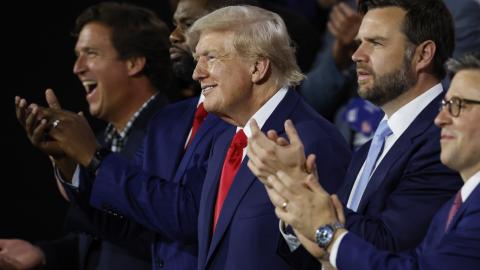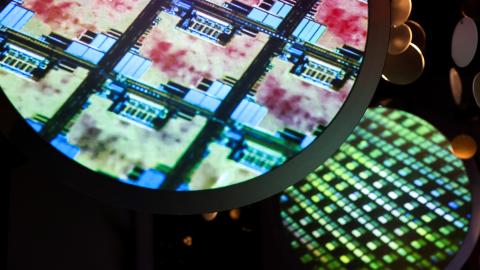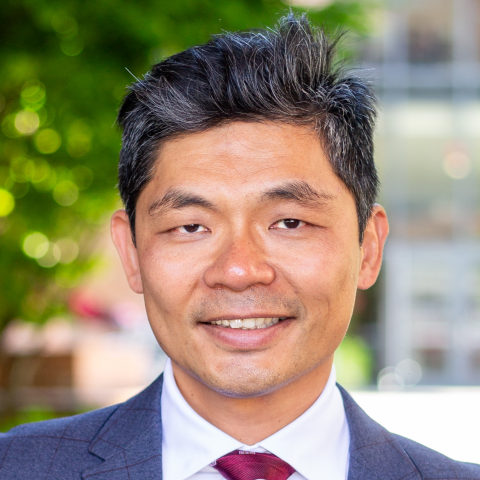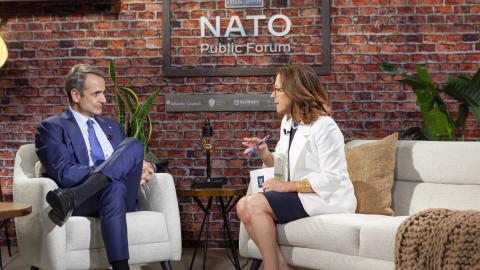What is the North Atlantic Treaty Organization? Why was it created? How do 32 countries work together effectively to ensure the security of all?
At the NATO Public Forum, Greek Prime Minister Kyriakos Mitsotakis answered these questions and more. With Hudson Senior Fellow Nadia Schadlow, he explored the history and geography of the world’s oldest and most successful military alliance and discussed why it is still relevant today.
Event Transcript
This transcription is automatically generated and edited lightly for accuracy. Please excuse any errors.
Nadia Schadlow:
Welcome back to the NATO Public Forum. I’m Nadia Schadlow, a senior fellow at the Hudson Institute, and it’s my pleasure this afternoon to have an opportunity to have a conversation with Greek Prime Minister Kyriakos Mitsotakis. Prime Minister, it’s really great to be here with you today. And since we only have a few minutes, I wanted to jump right in. When you became Prime Minister first in 2019, Europe looked different, and the challenges facing NATO seemed perhaps less intense than what we’re facing today. So could you talk to us a little bit about whether or not NATO has been adapting enough since 2019, since 2022? I know Greece has been really in the lead in terms of modernization and adaptation, but I’d love to hear your views.
Kyriakos Mitsotakis:
When I became Prime Minister in 2019, no one thought that we would be faced with a war at the heart of the European continent. But this is what we have to deal with after Russia’s unprovoked invasion of Ukraine. And I do believe that the alliance has adjusted and has tackled this momentous challenge as successfully as it could. Back in 2019, we were still faced with a question of whether enough European countries would meet the 2 percent commitment, 2 percent of defense spending as a percentage of GDP. Now, most countries have already met that target and those that haven’t have made very clear pledges that they will do so. Greece has been one of those countries that has surpassed the 2 percent threshold. Ever since essentially we joined the alliance, we’ll be spending 3 percent of our GDP on defense, significantly modernizing our armed forces, and thus contributing to the overall capabilities of the alliance. So new challenges force us to think differently also in terms of what this means for the collective European security as a pillar of the overall NATO integrated structure. And I think this discussion is advancing at a very fast pace in Europe.
Nadia Schadlow:
Yeah. So you mentioned European security. How do EU defense measures complement NATO, or how do you see the relationship between EU efforts to increase and substantially increase its defense and NATO? Is the relationship complementary, and how so?
Kyriakos Mitsotakis:
In my mind, it is fully complementary. We need to spend more, but we also need to be smarter about how we allocate our defense spending. When I look at the European defense industry, I see a lot of fragmentation. I don‘t see enough interoperability. I see a lot of, sometimes, maybe, I wouldn’t say a necessary competition, but certainly too many weapons systems that don‘t necessarily talk to each other. So we need to spend more, but we also need to be smarter about how we integrate our spending. And I guess I do think that at a time when the Russian invasion of Ukraine poses an existential threat for Europe, we also need to be creative in terms of finding new sources of funding in order to support our defense spending.
It is not just going to be enough to rely on national budgets as we have done so far. And that is why I‘ve been one of those strong proponents that we need some sort of European facility that will complement the defense spending that we undertake at the national level with more European funding. So this combination of public and private initiatives in my mind is going to be necessary if we build a solid European pillar when it comes to NATO‘s overall defense capabilities.
Nadia Schadlow:
So would that be some type of European fund or how do you envision that mechanism?
Kyriakos Mitsotakis:
We have submitted, with President Donald Tusk, a proposal for a flagship European project, which would essentially be a European Iron Dome that would complement the existing air defense capabilities that we have, which could be, again, I trust the word could be because we clearly don‘t have agreement at this stage, which could be funded through some sort of European joint borrowing. When we faced COVID back in 2020, we took the momentous decision to raise 750 billion euros to address the economic downturn that COVID caused to all of our economies. And this money is currently deployed. This was a European facility. So it seems to me that if we have raised 750 billion euros for the green of the digital transition to support our competitiveness, to protect jobs, it would be reasonable if we could raise a significantly lower sum at the European level to strengthen our European defense initiatives.
Nadia Schadlow:
And that would get us beyond always a discussion about the 2 percent, right? Also, it‘s different, it‘s ways to get to the 2 percent, but also ways to increase capabilities and integrated capabilities across Europe.
Kyriakos Mitsotakis:
And of course, also, ways to strengthen also our European defense industry at a time when we talk a lot about strategic autonomy, when the issue of competitiveness is at the top of our agenda, bolstering European defense cooperation, European innovation. We‘ve made some first steps at the European level in that direction, but we clearly need to do more.
Nadia Schadlow:
Right. And speaking of doing more has done an incredible amount for Ukraine. You ‘re one of the leading states in terms of providing the Ukrainians with missiles, with ammunition. What more do you think NATO needs to do quickly and how can we get there? A key theme throughout this past year really has been speed and NATO‘s ability, or lack thereof, to get things to Ukraine fast enough. And that‘s been a problem we‘ve had in the United States too. How do you think things might shift over the next few months, or what could be most meaningful to get us to act faster?
Kyriakos Mitsotakis:
Well, first of all, I think Europe has stepped up to the plate and has delivered. Back in 2022, I think many, including many in Moscow, would‘ve placed bets on the inability of Europe to remain united when it comes to supporting Ukraine. They were wrong. Europe remains united. We are providing Ukraine with European financial assistance, 50 billion euros. It‘s a significant package that we agreed a few months ago, but also member states are providing Ukraine with defense capabilities to the best of our abilities, and we will continue to do so. And initiatives such as a Czech Initiative, for example, have proven to be very efficient in terms of delivering aid to Ukraine as quickly as possible.
But at the same time, we need to look at the holes this has created to our own defense capabilities. And as much as we talk about sophisticated systems, we also need to make sure that we have the basics. I mean, Ukraine demonstrated how important, for example, 155 shells are, and that not everything is going to be as technology-driven in a modern war as many people thought. So making sure that we also streamline production, strengthen our stockpiles, while at the same time, having the capability to support Ukraine. This is a challenge that we have to meet.
Nadia Schadlow:
Right. Quantity matters.
Kyriakos Mitsotakis:
Quantity and quality.
Nadia Schadlow:
Can you tell us a little bit more about the Czech Initiative that you just mentioned in passing?
Kyriakos Mitsotakis:
Well, I think the Czech Initiative has proven to be an efficient way of transferring weapon systems to Ukraine. Many countries have joined that initiative, and as you pointed out, now, it‘s just up to speed and making sure that the necessary transactions, whenever they involve, for example, sale of equipment, take place as quickly as possible. And it seems to me that this is one avenue which is worth exploring further.
Nadia Schadlow:
So as we close, what is your hope for the 75th Public Forum? What do you think NATO, what would you like to see out of the 75th Anniversary Summit?
Kyriakos Mitsotakis:
Well, first of all, I think it is important to take stock of what we have achieved. NATO has been successful because it has been able to adapt and occasionally even reinvent itself. And this is exactly what we need to do now. For me, the most crucial aspect of NATO has always been the strength of the transatlantic partnership. And I think it is very, very important that we maintain this mutual commitment, but to also recognize that in an alliance, we all need to do our own part. There are no free riders.
And that is why meeting the 2 percent commitment is so important, at least for those countries that have always been very consistent with this target. And maybe at some point, we will need to discuss about raising it. Maybe 2 percent is not enough. Maybe we need to get to 2.5 percent if we really want to deliver everything we want to do within the alliance. But the one thing which is certain is that at a time of great uncertainty, being part of an alliance that is strong, defensive, and capable of defending us all against external threats is as important as it has ever been.
Nadia Schadlow:
Well, thank you so much.
Kyriakos Mitsotakis:
Thank you.
Nadia Schadlow:
It‘s been a pleasure. Thank you.
Kyriakos Mitsotakis:
Thank you.



















